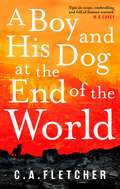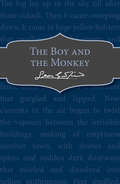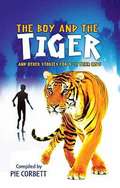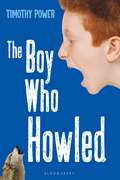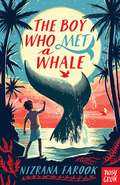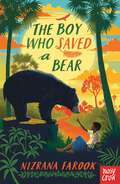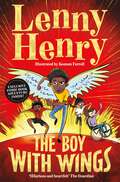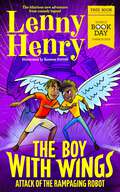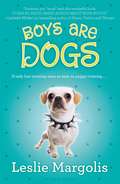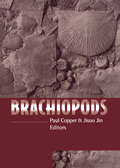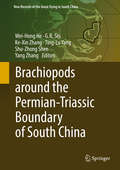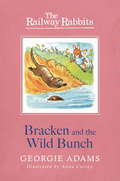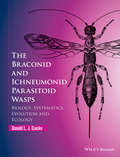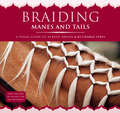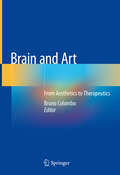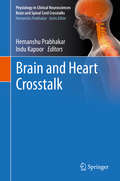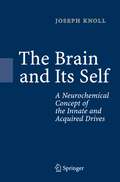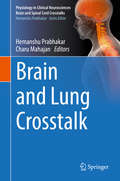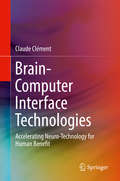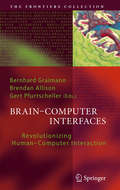- Table View
- List View
Box Jellyfish (Large Print)
by Rnib BookshareThis is an image of a box jellyfish shown from the side. There is a locator dot shown, which will be at the top left of the page when the image is the right way up. At the top centre of the page is the dome-shaped body of the jellyfish. Along the lower part of its body, three of its four sets of long, thin, stringy tentacles stretch down the page.
Box Jellyfish (UEB Contracted)
by Rnib BookshareThis is an image of a box jellyfish shown from the side. There is a locator dot shown, which will be at the top left of the page when the image is the right way up. At the top centre of the page is the dome-shaped body of the jellyfish. Along the lower part of its body, three of its four sets of long, thin, stringy tentacles stretch down the page.
Box Jellyfish (UEB Uncontracted)
by Rnib BookshareThis is an image of a box jellyfish shown from the side. There is a locator dot shown, which will be at the top left of the page when the image is the right way up. At the top centre of the page is the dome-shaped body of the jellyfish. Along the lower part of its body, three of its four sets of long, thin, stringy tentacles stretch down the page.
A Boy and his Dog at the End of the World: A Novel
by C. A. FletcherTHE MOST POWERFUL STORY YOU'LL READ THIS YEAR.'You'll remember A Boy and His Dog at the End of the World long after you finish reading'Peng Shepherd, author of The Book Of M 'Fletcher's suspenseful, atmospheric tale imagines a near future in which our world is in ruins . . . an adventure saga punctured by a gut-punch twist'Entertainment Weekly'Truly engrossing . . . brings hope and humanity to a cold and scary world'Keith Stuart, author of A Boy Made of Blocks 'I promise you're going to love it'Louisa Morgan, author of A Secret History of Witches'Epic in scope, enthralling, and full of human warmth'M. R. Carey, author of The Girl with all the Gifts THE WORLD HAS ENDED. AT LEAST WE STILL HAVE DOGS.My name's Griz. I've never been to school, I've never had friends, in my whole life I've not met enough people to play a game of football. My parents told me how crowded the world used to be, before all the people went away, but we were never lonely on our remote island. We had each other, and our dogs.Then the thief came. He told stories of the deserted towns and cities beyond our horizons. I liked him - until I woke to find he had stolen my dog. So I chased him out into the ruins of the world.I just want to get my dog back, but I found more than I ever imagined was possible. More about how the world ended. More about what my family's real story is. More about what really matters.'This un-put-down-able story has everything - a well-imagined post-apocalyptic world, great characters, incredible suspense, and, of course, the fierce love of some very good dogs'Kirkus (starred review)'A story that is as heart-warming as it is heart-breaking'Fantasy Hive 'A stunningly gorgeous read: masterful storytelling, searingly beautiful prose, and a world so meticulously rendered you'll forget there's a real one going on beyond the pages. A book of the year contender - in any year'Micah Yongo'Extraordinary and quite magnificent . . . 10/10'StarburstA Boy and his Dog at the End of the World is the most moving story you'll read this year. Perfect for readers of Life of Pi, The Girl with all the Gifts or Station Eleven - Griz's tale mixes sadness and hope in one unforgettable character's quest amid the remnants of our fragile civilisation.
The Boy and the Monkey
by Leon GarfieldSet in the streets of London, the story follows the hopes and aspirations of young Tim and his pet monkey, Pistol, as they use their wits to get money out of rich folk. Their apparent success is brought to a halt one disasterous foggy evening , and Tim and Pistol are led off to Newgate Gaol . . .
The Boy and the Tiger and other stories for 9 to 11 year olds (Pie Corbett's Storyteller)
by Ray Burrows Corrine BurrowsDon't just read - read aloud! With a treasure-trove of favourite tales, each accompanied by an audio retelling from a professional storyteller, this book gives children the perfect opportunity to read aloud, listen along, follow text, read together and do all the things they need to build their literacy skills! They'll meet tigers, giants and much more in this captivating collection.
The Boy Who Howled
by Timothy PowerAs far back as Callum can really remember, he's been living in the Wild as the furless mascot of a wolf pack. But when his pack sends him back to live with his own kind-humans-fitting in is quite a challenge. He doesn't remember English very well, so he accidentally says his name is "Clam." He's spent most of his life eating fresh-killed elk, so dining with vegetarians is tricky. And when he tries to impress the Alpha student in the school cafeteria by stealing food, people seem offended!A mix of wildness and humor, Timothy Power's inventive writing makes him a debut author to watch. And Callum's quest to find his place in a strange world will have readers rooting for him-when they're not howling with laughter.
The Boy Who Met a Whale
by Nizrana FarookFrom the author of The Girl Who Stole an Elephant comes another brilliant escapade. A thrilling adventure set in fictional Sri Lanka, jam-packed with peril and kidnap and a huge blue whale! Razi, a local fisherboy, is watching turtle eggs hatch when he sees a boat bobbing into view. With a chill, he notices a small, still hand hanging over the side... Inside is Zheng, who's escaped a shipwreck and is full of tales of sea monsters and missing treasure. But the villains who are after Zheng are soon after Razi and his sister, Shifa, too. And so begins an exhilarating adventure in the shadow of the biggest sea monster of them all...
The Boy Who Saved a Bear
by Nizrana FarookA boy and a bear meet, become friends and have the adventure of their lives! From the author of The Girl Who Stole an Elephant comes another brilliant escapade. The fourth thrilling adventure set in a fictional Sri Lanka is jam-packed with peril, thieves and a terrifying bear! Nuwan works at the library, delivering books. One day, he accidentally takes away a very valuable key that's been hidden inside one of the books, and in the process thwarts the plans of some very dangerous thieves. On the run, he hides in a cave, only to discover in the middle of the night that he is sharing it with a big, hairy, terrifying bear! After some hair-raising moments, he and the bear reach an understanding and they travel on together, evading the bad guys and hoping the key will unlock the answers to the mystery so that they can stop running and return home... Cover and inside illustrations by David Dean.
The Boy With Wings
by Lenny HenryLenny Henry's hilarious new adventure, The Boy with Wings, is for readers of 9 to 12 and illustrated throughout by Keenon Ferrell. Includes an exclusive comic book adventure illustrated by Mark Buckingham.An ordinary kid is about to become an EXTRAORDINARY hero!Wings? Check.A super-cool, super-secret past? Check.An impossible mission to save the world from a fur-ocious enemy? Check.When Tunde sprouts wings and learns he’s all that stands between Earth and total destruction, suddenly school is the least of his problems. Luckily, his rag-tag group of pals have got his back, and with his new powers, Tunde is ready to fly in the face of danger.So what if he can’t even stand up to the school bully? He’s the boy with wings – this is his destiny.No pressure then. . .
The Boy With Wings: Attack of the Rampaging Robot - World Book Day 2023
by Lenny HenryThe Boy with Wings is back for a thrilling World Book Day adventure . . .Tunde Wilkinson is an ordinary kid. He has awesome friends, sometimes embarrassing parents and needs to be careful his wings don't get in the way on the football pitch.Wait . . .wings?Oh yeah, Tunde is also a secret superhero.When a new kid starts at his school and is better than him at everything, not even Tunde's friends seem on his side. Does this new kid have a connection to the shady Facility? And can Tunde figure it all out before an evil robot destroys their town?Take flight with Tunde in the Attack of the Rampaging Robot, the exciting Boy With Wings adventure by Lenny Henry!
Boys Are Dogs (Annabelle Unleashed)
by Leslie MargolisThe book that inspired the Disney Channel movie Zapped, starring Zendaya! When Annabelle returns from summer camp, her life is totally different. She's moving to a new house with her mom's new boyfriend, and that means starting sixth grade at a brand-new school. Birchwood Middle School is very different from her old all-girls elementary-the boys practically run wild in the hallways. And at home, Annabelle's new puppy is taking over the house and chewing on her clothes. But the puppy came with a training manual, so Annabelle might be able to get one thing under control. Unless . . . can you train a boy the way you train a dog?Look for the other books in this series, Girls Acting Catty, and Everybody Bugs Out!
Brachiopods
by Paul CopperThis collection of conference papers presents information on the molecular genetics, biomineralization, growth and ecology of extant brachiopod stocks (extrapolated back to the Cambrian), and the shell microstructure, taphonomy, paleogeography, evolution, and taxonomy of fossil brachiopods.
Brachiopods: The O/s Extinction Recovery Fauna (Special Papers In Palaeontology Ser. #No. 74)
by Paul CopperThis collection of conference papers presents information on the molecular genetics, biomineralization, growth and ecology of extant brachiopod stocks (extrapolated back to the Cambrian), and the shell microstructure, taphonomy, paleogeography, evolution, and taxonomy of fossil brachiopods.
Brachiopods around the Permian-Triassic Boundary of South China (New Records Of The Great Dying In South China Ser.)
by Wei-Hong He G. R. Shi Ke-Xin Zhang Ting-Lu Yang Shu-Zhong Shen Yang ZhangThis timely book documents marvelous brachiopod fossils from the Palaeozoic-Mesozoic transition of South China. Numerous beautiful pictures and detailed descriptions (specifically the measurements of body size) of brachiopod species are presented. Systematic discussion on the evolution of brachiopod biodiversity and morphological features across the critical interval is not only extremely important for paleontologists to understand the marine ecosystem evolution from the Palaeozoic to the Mesozoic, but also attractive for students who need to know about the end-Permian mass extinction. The book distinguishes itself from other studies by its detailed study of the taxonomy, biodiversity and paleoecology of Permian-Triassic brachiopods from different palaeogeographic facies, especially from the deep-water environment in South China. The book also offers a unique study of the response of morphological features of brachiopods to palaeoenvironmental changes, providing insights for the process of Permian-Triassic crisis.
Bracken and the Wild Bunch: Book 11 (Railway Rabbits #11)
by Georgie AdamsMeet the Railway Rabbits! Join the irrepressible Longears family as they get in and out of scrapes, meet new friends, and perform daring rescues. But Burdock the buzzard and the terrifying Red Dragon, are always on the lookout for naughty rabbits who stray too far from home...Fun and games for Bracken when he meets some mischievous otters who play havoc along the riverbank. Heartwarming, hilarious, with Anna Currey's charming illustrations, this is a brilliant new animal adventure series from a best selling children's author.
The Braconid and Ichneumonid Parasitoid Wasps: Biology, Systematics, Evolution and Ecology
by Donald L. QuickeThe Ichneumonoidea is a vast and important superfamily of parasitic wasps, with some 60,000 described species and estimated numbers far higher, especially for small-bodied tropical taxa. The superfamily comprises two cosmopolitan families - Braconidae and Ichneumonidae - that have largely attracted separate groups of researchers, and this, to a considerable extent, has meant that understanding of their adaptive features has often been considered in isolation. This book considers both families, highlighting similarities and differences in their adaptations. The classification of the whole of the Ichneumonoidea, along with most other insect orders, has been plagued by typology whereby undue importance has been attributed to particular characters in defining groups. Typology is a common disease of traditional taxonomy such that, until recently, quite a lot of taxa have been associated with the wrong higher clades. The sheer size of the group, and until the last 30 or so years, lack of accessible identification materials, has been a further impediment to research on all but a handful of ‘lab rat’ species usually cultured initially because of their potential in biological control. New evidence, largely in the form of molecular data, have shown that many morphological, behavioural, physiological and anatomical characters associated with basic life history features, specifically whether wasps are ecto- or endoparasitic, or idiobiont or koinobiont, can be grossly misleading in terms of the phylogeny they suggest. This book shows how, with better supported phylogenetic hypotheses entomologists can understand far more about the ways natural selection is acting upon them. This new book also focuses on this superfamily with which the author has great familiarity and provides a detailed coverage of each subfamily, emphasising anatomy, taxonomy and systematics, biology, as well as pointing out the importance and research potential of each group. Fossil taxa are included and it also has sections on biogeography, global species richness, culturing and rearing and preparing specimens for taxonomic study. The book highlights areas where research might be particularly rewarding and suggests systems/groups that need investigation. The author provides a large compendium of references to original research on each group. This book is an essential workmate for all postgraduates and researchers working on ichneumonoid or other parasitic wasps worldwide. It will stand as a reference book for a good number of years, and while rapid advances in various fields such as genomics and host physiological interactions will lead to new information, as an overall synthesis of the current state it will stay relevant for a long time.
The Braconid and Ichneumonid Parasitoid Wasps: Biology, Systematics, Evolution and Ecology
by Donald L. QuickeThe Ichneumonoidea is a vast and important superfamily of parasitic wasps, with some 60,000 described species and estimated numbers far higher, especially for small-bodied tropical taxa. The superfamily comprises two cosmopolitan families - Braconidae and Ichneumonidae - that have largely attracted separate groups of researchers, and this, to a considerable extent, has meant that understanding of their adaptive features has often been considered in isolation. This book considers both families, highlighting similarities and differences in their adaptations. The classification of the whole of the Ichneumonoidea, along with most other insect orders, has been plagued by typology whereby undue importance has been attributed to particular characters in defining groups. Typology is a common disease of traditional taxonomy such that, until recently, quite a lot of taxa have been associated with the wrong higher clades. The sheer size of the group, and until the last 30 or so years, lack of accessible identification materials, has been a further impediment to research on all but a handful of ‘lab rat’ species usually cultured initially because of their potential in biological control. New evidence, largely in the form of molecular data, have shown that many morphological, behavioural, physiological and anatomical characters associated with basic life history features, specifically whether wasps are ecto- or endoparasitic, or idiobiont or koinobiont, can be grossly misleading in terms of the phylogeny they suggest. This book shows how, with better supported phylogenetic hypotheses entomologists can understand far more about the ways natural selection is acting upon them. This new book also focuses on this superfamily with which the author has great familiarity and provides a detailed coverage of each subfamily, emphasising anatomy, taxonomy and systematics, biology, as well as pointing out the importance and research potential of each group. Fossil taxa are included and it also has sections on biogeography, global species richness, culturing and rearing and preparing specimens for taxonomic study. The book highlights areas where research might be particularly rewarding and suggests systems/groups that need investigation. The author provides a large compendium of references to original research on each group. This book is an essential workmate for all postgraduates and researchers working on ichneumonoid or other parasitic wasps worldwide. It will stand as a reference book for a good number of years, and while rapid advances in various fields such as genomics and host physiological interactions will lead to new information, as an overall synthesis of the current state it will stay relevant for a long time.
Braiding Manes and Tails: A Visual Guide to 30 Basic Braids
by Charni LewisGive your horse a gorgeous look! Charni Lewis provides step-by-step instructions for 30 mane and tail braids for both casual outings and specialized events of all riding styles. Full-color photographs and detailed illustrations bring every twist and turn to life, while also clearly demonstrating proper hand positioning. Get inspired and experiment with a Scalloped mane braid or a Four-Strand Weave for the tail. Not only will your horse look great, the time you spend braiding will help develop that special bond between you and your horse.
Brain and Art: From Aesthetics to Therapeutics
by Bruno ColomboThis book analyzes and discusses in detail art therapy, a specific tool used to sustain health in affective developments, rehabilitation, motor skills and cognitive functions. Art therapy is based on the assumption that the process of making art (music, dance, painting) sparks emotions and enhances brain activity. Art therapy is used to encourage personal growth, facilitate particular brain areas or activity patterns, and improve neural connectivity. Treating neurological diseases using artistic strategies offers us a unique option for engaging brain structural networks that enhance the brain’s ability to form new connections. Based on brain plasticity, art therapy has the potential to increase our repertoire for treating neurological diseases. Neural substrates are the basis of complex emotions relative to art experiences, and involve a widespread activation of cognitive and motor systems. Accordingly, art therapy has the capacity to modulate behavior, cognition, attention and movement. In this context, art therapy can offer effective tools for improving general well-being, quality of life and motivation in connection with neurological diseases. The book discusses art therapy as a potential group of techniques for the treatment of neurological disturbances and approaches the relationship between humanistic disciplines and neurology from a holistic perspective, reflecting the growing interest in this interconnection.
Brain and Heart Crosstalk (Physiology in Clinical Neurosciences – Brain and Spinal Cord Crosstalks)
by Hemanshu Prabhakar Indu KapoorThis book discusses the underlying mechanisms connecting the brain and heart. The physiology of the brain is such that it is easily affected by any altered physiology of other systems, which in turn may compromise cerebral blood flow and oxygenation. Together, the brain and heart control our body systems, allowing them to function automatically. This interaction between the brain and other systems makes it important for us to understand how any kind of injury to the brain can produce complications in remote organs or systems, such as the heart. The central nervous system is responsible for vegetative function and is central to homeostasis. Further, central nervous system responses are linked to the ongoing function of other organ systems e.g. feeding, thermoregulation, reproduction and muscle activity. It is therefore logical that neural control of the cardiovascular system must also interact with the neural control of other organ systems. This book explains in detail stressed cardiac conditions, discussing the pathophysiology and proposed treatment, and also describing lesser-known crosstalks between the acutely or chronically affected brain and heart.
The Brain and Its Self: A Neurochemical Concept of the Innate and Acquired Drives
by Joseph KnollThe main message of this monograph is that the appearance of the mammalian brain with the ability to acquire drives ensured the development of social life, and eventually led to the evolution of the human society. This most sophisticated form of organized life on earth is still in the trial and error phase of its development. It seeks to outgrow the myth-directed era of its history and come to its final state, the ration-directed human society.
Brain and Lung Crosstalk (Physiology in Clinical Neurosciences – Brain and Spinal Cord Crosstalks)
by Hemanshu Prabhakar Charu MahajanThe central nervous system, which includes the brain and spinal cord, has a high metabolic demand. The physiology of the brain is such that it is easily affected by alterations in other systems, which in turn can compromise cerebral blood flow and oxygenation. Together the brain and spinal cord control the automatic function of our body systems. While other systems of body controls individual functions, central nervous system at the same time does many different functions, especially, controlling the function of other systems. This interaction between the brain and other systems is important when it comes to understanding how injuries to the brain can, at times, produce complications in remote organs or systems of the body, such as the lungs. This book explains the lesser-known crosstalks between acutely or chronically affected brain and lung, describing the pathophysiology of the lung following brain injury and discussing in detail the conflicts between the brain and lungs in relation to the tidal volumes, positive end-expiratory pressures, arterial carbon dioxide and oxygen levels, recruitment maneuvers and positioning, as well as potential therapeutic targets.
Brain-Computer Interface Technologies: Accelerating Neuro-Technology for Human Benefit
by Claude ClémentThis book is about the field of brain-computer interfaces (BCI) and the unique and special environment of active implants that electrically interface with the brain, spinal cord, peripheral nerves, and organs. At the heart of the book is the matter of repairing and rehabilitating patients suffering from severe neurologic impairments, from paralysis to movement disorders and epilepsy, that often requires an invasive solution based on an implanted device. Past achievements, current work, and future perspectives of BCI and other interactions between medical devices and the human nervous system are described in detail from a pragmatic point of view.Reviews the Active Implantable Medical Devices (AIMDs) industry and how it is moving from cardiac to neuro applicationsClear, easy to read, presentation of the field of neuro-technologies for human benefitProvides easy to understand explanations about the technical limitations, the physics of implants in the human body, and realistic long terms perspectives
Brain-Computer Interfaces: Revolutionizing Human-Computer Interaction (The Frontiers Collection #6)
by Bernhard Graimann Gert Pfurtscheller Brendan AllisonA brain-computer interface (BCI) establishes a direct output channel between the human brain and external devices. BCIs infer user intent via direct measures of brain activity and thus enable communication and control without movement. This book, authored by experts in the field, provides an accessible introduction to the neurophysiological and signal-processing background required for BCI, presents state-of-the-art non-invasive and invasive approaches, gives an overview of current hardware and software solutions, and reviews the most interesting as well as new, emerging BCI applications. The book is intended not only for students and young researchers, but also for newcomers and other readers from diverse backgrounds keen to learn about this vital scientific endeavour.

